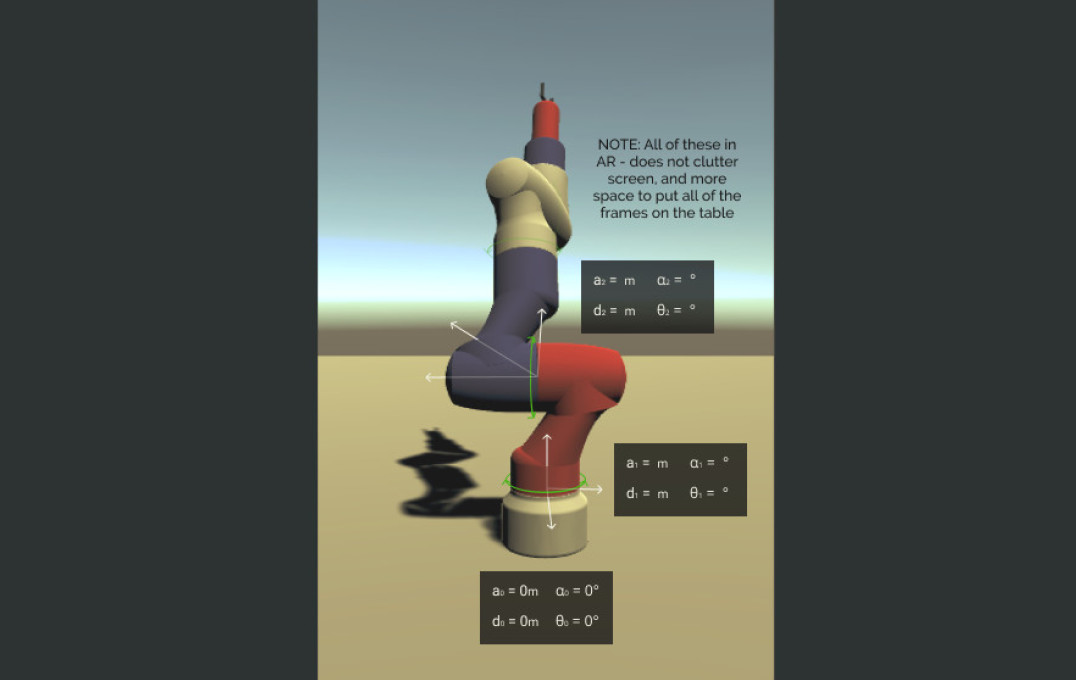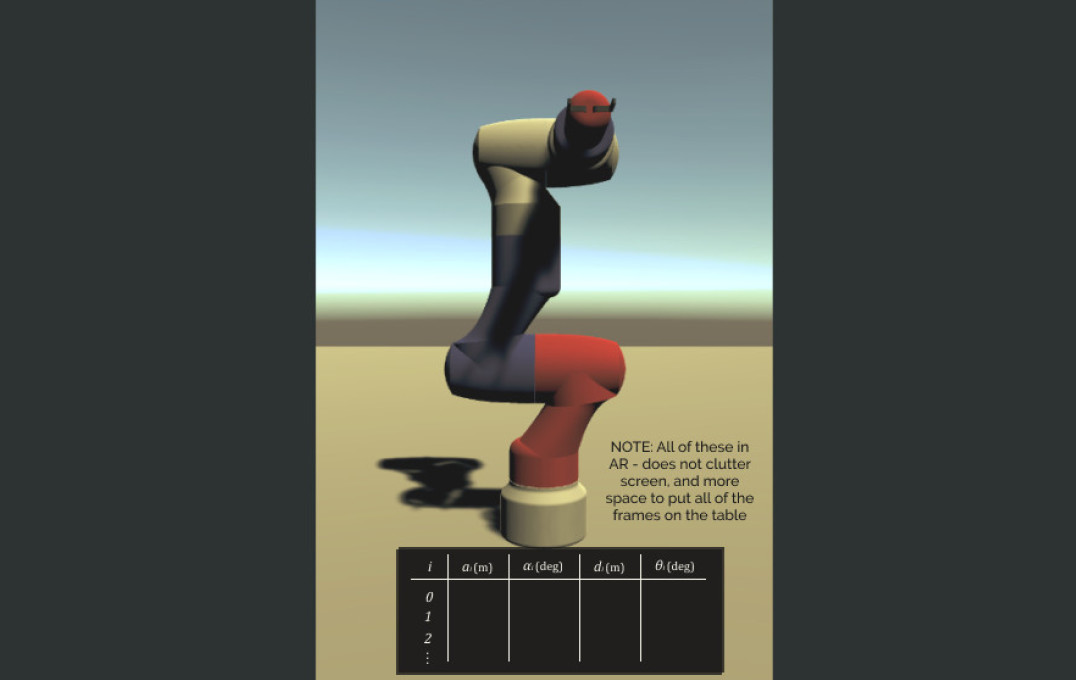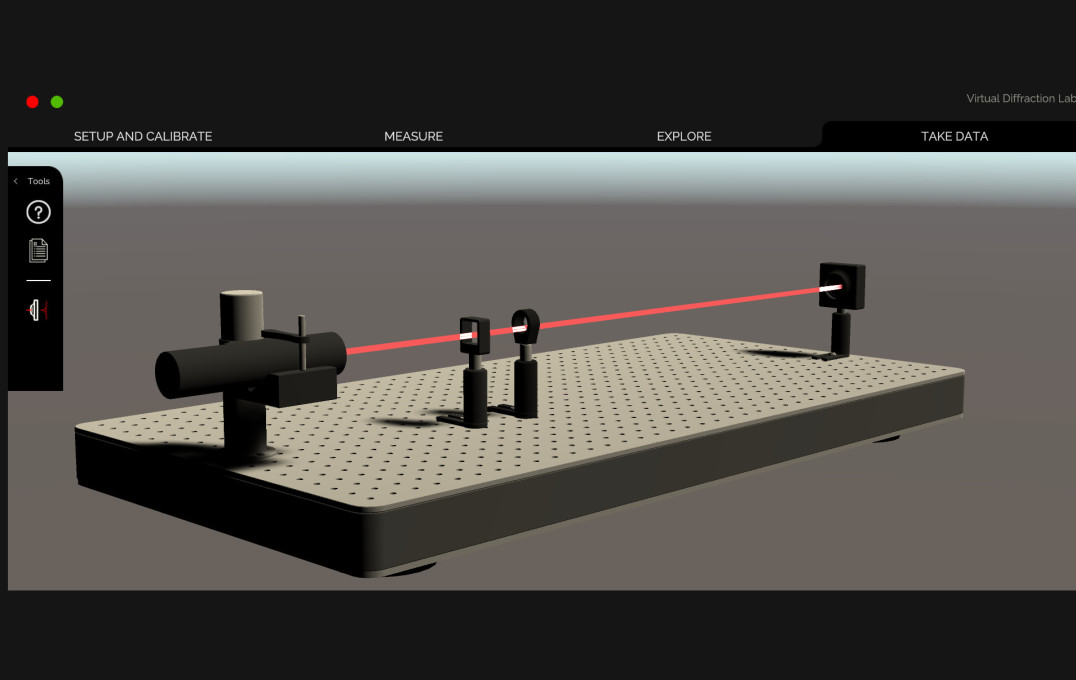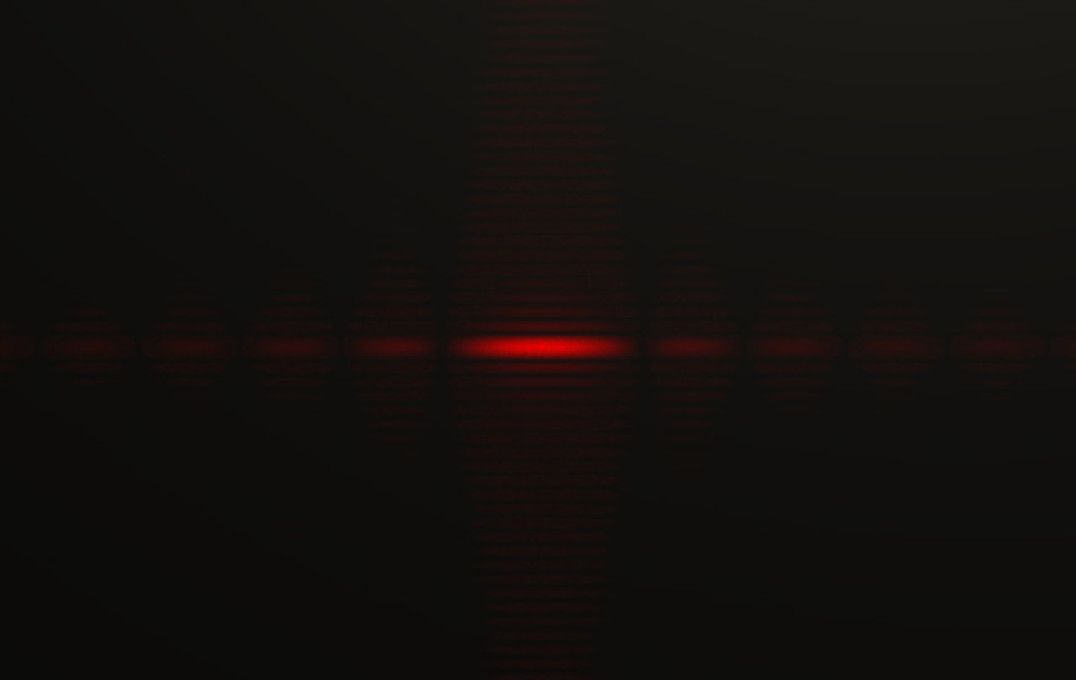Imperial students break new ground in STEM teaching creating virtual physics lab
A team of students has developed a virtual physics lab, with exciting possibilities for the future of education.
The team of six undergraduates has been working with academics from the Department of Physics, the Digital Learning Hub (DLH) and the FoNS Ed Tech team. We caught up with four members – Camilla Billari (Design Engineering), Tim Heightman (Physics), Luke Murray (Physics) and Abdullah Rehman (Biomedical Engineering), plus Thomas Hurkxkens, Lead New Media at the DLH, to find out more about how their app is set to break new ground in STEM teaching, and how virtual and augmented realities (VR / AR) provide unique and exciting possibilities for the future of education.
Hi everyone! So how did the project get started?
Thomas: The DLH creates a space where students and academics can explore and test new technologies they want to try in education. Last December, Tim and I met around a project called Imperial Visualisations, where concepts in maths or physics are visualised online. We spoke about the strength of that project, but what seemed to be missing was a way to really interact with 3D objects.
Tim: Currently you have these semi-interactive, two-dimensional applets, which are very much supplements to the learning experience. We were looking for more immersive, full-scale learning experiences, to see if we could re-form how we were teaching and learning about physics, which hasn’t really changed much in the past a hundred years!
The pandemic has fast-tracked a sudden shift towards remote learning, in a way that you may not have foreseen back in December…
Tim: Yeah, the pandemic ended up being a catalyst. What we’re hoping is that as teaching staff and students need to engage in this kind of material, they’ll see the huge educational benefits of using this medium, seeing just how much educational potential holographic simulations have.
Thomas: We started with an assumption that students would be engaging with the material together in a classroom. As the pandemic evolved, we adapted our focus to teaching students in a fully online environment.
You used the platform Unity to develop your app – what is Unity?
Tim: What isn’t Unity! Unity is basically a software development platform usually used for video games, but it’s very flexible and completely device agnostic, so you can also use it to build learning experiences, VR mobile apps, computer software all in one. It allows you to integrate virtual and holographic three-dimensional objects, providing the perfect middle-ground between purely computational physics, algorithm simulation, and a really nice graphical user interface.
At the moment the app is completely VR but we hope in the future to branch out into AR, which would mean that you could do optics from your kitchen table – that would be cool Tim Heightman Undergraduate, Department of Physics
Luke: A lot of the time when you’re developing simulations as Undergraduates, the actual visual output is very bare bones, an aesthetic you might imagine from the late nineties, nothing that really snaps. The great thing about Unity is that it lets us plug advanced simulations into a kind of real-world format. It provides so many features that ease that transition, in terms of bringing our ideas into a physical space.
Thomas: The Imperial Immersive Technology Initiative partners with Unity to supply this platform for our students. It’s a really interesting platform to work with.
Tell us more about the lab and how you see it integrating into Imperial’s Physics programmes
Tim: Our lab is designed to let students investigate scalar diffraction. In a real-life lab, students are required to set up and calibrate optical equipment and learn how to understand mathematical relationships behind the different visual patterns they see. Once a far field limit has been applied to the set-up, a lot of different aspects of the patterns they see end up showing different properties of how Fourier Transforms work. What learners should walk away with is a visual and mathematical intuition allowing them to predict what patterns they might see, given what kind of diffraction object they use.
Thomas: The VR lab designed to make the real-life lab experience more effective, not to replace it entirely. We’ve created a safe space where you can just try out equipment, without the fear of failing! Students can run an experiment over and over again, so that when they enter a real lab, they feel more confident and can use their time more effectively. The feedback we’ve had from academics already indicates that this will be incredibly useful beyond the immediate pandemic situation.
Tim: We’re augmenting the learning experience by offering extra visualisations and learning tools that you wouldn’t get in a real-life lab. It should help bridge the gap between the ideal mathematical theory world that physicists so often dream of, and the experimental world full of dodgy kit, experimental errors and other unpredictable elements. It offers a kind of middle ground, a space where you can test the theory quite rigorously in a semi-real-life experimental context. At the moment the app is completely VR but we hope in the future to branch out into AR, which would mean that you could do optics from your kitchen table – that would be cool.
How did you get involved in the project?
Camilla: My focus has been on the front-end and the design, making sure the user interface is intuitive and that it reflects the learning experience we were keen to establish from the start. We wanted to make the experience make sense virtually, but also in a way that it resembled a real lab. What’s great with Unity is that it ties everything together really effectively, so collaborating on similar tasks was easy, especially given we did all of this remotely.
Luke: I've also focused on front-end development, providing a link between Camilla's amazing design work and the technical back end aspects done by Patrick [Masso Walsh], Martin [Ignatov] and Abdullah. This involves not just working on the user-interface, but also ensuring that the way users interact with our 3D components is natural. COVID has suddenly increased our reliance on the digital world – we want to make that transition easier by making the user-experience more natural and efficient.
Abdullah: I worked mainly on the back-end. With the help of Tim and Patrick we got our very own optics engine running, set up in a way that means it isn't just producing one specific output, but rather providing nice variables. The lab can therefore be uniquely tailored to each individual user’s experience. Unity is used to tie all the different components together.
Tim: I had the role of Lead Developer, which basically means project managing, making sure things run smoothly, doing a bit of everything depending on what's needed at the time.
Most gaming engines are easily capable of ray tracing, and they claim they can do diffraction, but the way they do it is very baked, it’s all a bit fudgy. What we needed was something high resolution and accurate enough that you could take data from it, and run complex physics tasks. That's the reason we had to build our own hybrid ray tracer/Fourier optics engine.
Abdullah: I’ve learned a lot about physics labs, but other opportunities have also stemmed from the project – collaborations with people in other departments – allowing us to gain knowledge in so many different areas by applying our ideas to different contexts and environments. This technology can essentially be applied to everything, which is really something to look forward to.
Tim: Yeah, if an academic, or a group approaches us and says, hey can you build this, we then get to go and find out about a fascinating niche field of science that we’d never have touched before.
Camilla: I think the fact that we come from different departments is one of the strengths of the project – we’ve been able to approach ideas and tasks in a variety of ways from our different areas of expertise, and work effectively in the time we had.
What tech skills have you gained?
Luke: We dedicated a week at the start to training and getting our heads around Unity. It’s definitely been a steep learning curve that’s helped us galvanise our technical skills. With a physics background you have a baseline level of coding available, but many other skills are required. There are multiple ways of achieving something as simple as moving objects and have them respect gravity in Untiy, for example, so you need to have a bit of a creative streak. It’s not like other kinds of physics projects where the theory has already been well established and it’s all well-mapped out. With this, you perhaps need to consider five different approaches for achieving something because you might hit a stumbling block. You also need to think about what the back end are doing – everything has to work together – and I just love the kind of interplay we’ve had going through the team.
Camilla: I completely agree. I’d done some design work and programming before as part of my degree in design engineering, using Adobe CC, CAD, Python and JavaScript – the typical software and languages you’d usually start out with – but I’d not used Unity. This was definitely a more full-on experience with a very steep learning curve, but exciting and rewarding. I’m used to rapid prototyping, but for this project I really had to step up the quality of my work to make a virtual experience that can be effectively used by students.
Do you have any advice for students interested in extra-curricular projects like this, or expanding their knowledge in this area?
A base level knowledge is ideal, but just the kind of raw drive that a lot of Imperial students have is fantastic. Luke Murray Undergraduate, Department of Physics
Camilla: In terms of just getting started, online tutorials are a great place to start. Pick a platform that you like and start experimenting, but set yourself a goal to achieve, even if it is just a small visualisation or minigame. Even better, get involved in projects like this! Being in a team really pushes you to rapidly learn and get things done. We achieved things together, mind-mapping ideas and discussing possibilities constantly working with, and learning from, each other. Having strict deadlines forced us to find solutions to problems ourselves from the internet, but more importantly, to learn from each other.
Luke: One of the most valuable things for us as Imperial students is the kind of intensity of work we experience during our degree programmes. Staff and students here are so interested in their subjects, the amount of hours they put in really pays off when you then get the opportunity to get involved in projects like this, because everyone has such enthusiasm and something to offer. A base level knowledge is ideal, but just the kind of raw drive that a lot of Imperial students have is fantastic.
Tim: It takes a certain type of drive to embark on high-pressure, heavy hours degrees that require huge amounts of commitment – as a student, you don’t always realise this, but as a result you develop a huge skill set. Getting involved in a project like this really is a case of just having a go, and getting in touch with the great support that’s on offer. I contacted Thomas and told him the beginnings of an idea, and so much has come out of that.
Thomas: What I see is that students are really positive about these new ways of teaching and learning – using VR in the classroom or online. I’d say if you’re interested in that combination of education and testing your skills, look for partnerships with your teachers. Imperial has a very open culture and you can often collaborate together to create the education that you envision.
Camilla: Imperial degrees can be really challenging and if there’s a way of adding to the curriculum that makes the content more accessible and enjoyable to engage with, it can make a huge difference. You can always go back to the VR lab after having completed it for your course, to experiment some more. It’s great to have the opportunity to give back something to the education of others based on our own experiences, and that of previous students.
Tim: I definitely envision our group engaging collaboratively with Imperial in the future, so if there are students who want to pursue related ideas, there’s no harm in contacting us.
How do you think VR and AR will change the educational experience of the future?
Tim: The demand for products and learning experiences like this right now is huge, but this shift towards digital learning is equally as relevant in the long-term. This technology offers a new wave of educating in STEM. Instead of focusing solely on theory and then shifting to experiments, and never really being able to link the two properly, it offers a middle-ground where you can rigorously test your conceptual ideas and develop a conceptual intuition, and at the same time get experimental value out of your learning experience. There’s a huge scope there. We’re hoping that if we’re able to extend the project, we might turn this into a full optics lab where users can set up any experiment they wish and explore how components interact with each other.
We all have slightly different images in our heads when we learn ... sharing these concepts has made our app more effective, because we've combined our different viewpoints to create the final visualisations. Camilla Billari Undergraduate, Department of Design Engineering
Luke: The way I’ve always learnt physics is by visualising things, whether that’s in an arbitrary way, where I’m just imagining it free-floating in the air, or imagining it on the table in front of me, internal visualisation has always been a very powerful tool. Not everyone’s inclined to do that, or even able to do that, and that can be quite a barrier to people getting into STEM and enjoying it and learning the intricacies of it.
If there are a visual effects or phenomena you’re not too sure about, you might be able to locate a visualisation online, which is likely to be static on a screen, or a crude animation that takes place in some kind of virtual space. The beauty of this technology is it allows people to directly access the skill of visualisation, or shows them a different way of looking at something.
Tim: I’m secretly an auditive learner, which I probably shouldn’t admit as a visual designer! But one thing I’ve really struggled with in physics is being able to visualise. I really have to actively engage my thought to be able to visualise different concepts, it’s not something that happens passively, and I know I’m not the only one like this. What this app does is level the playing field for different types of learners – auditive, visual, kinaesthetic – giving everyone an equal footing to understand these complicated concepts and develop intuition without hindrance due to their learning style. It caters for everybody.
Camilla: I’m a visual learner, but I think we all have slightly different images in our heads when we learn. Being in a group and sharing these concepts has made our app more effective, because we've combined our different viewpoints to create the final visualisations, which might be really useful for both visual and non-visual learners.
This tool could be especially useful in engineering, where you have to think about effects from the atomic to the macro scale, and how they tie into and relate to each other. There’s so much theory that you have to absorb …we’ve developed something that can connect those dots. Abdullah Rehman Department of Biomedical Engineering
Abdullah: I remember thinking early on what the benefits of this tool could be, especially in engineering where you have to think about the effects from the atomic scale to the macro scale, and how those effects tie into and relate to each other. There’s so much theory that you have to absorb, reading it over multiple times to try and understand it – you can’t possibly visualise some of these concepts. We’ve developed something that can connect those dots.
Tim: Academics often teach in a very structured, similar way to the way their own teachers did, and their teachers before them and so on. Sometimes the onus can be placed on the student to find interesting ways to engage in their education. It’s brilliant when that responsibility is shared between the student and their teachers, and when teachers evaluate their own methods based on how students are engaging, branching into immersive and innovative learning experiences. Sometimes teaching staff might deliver their lectures in a particular way because they think that’s the only way there is to do it. Hopefully what we’ll show by deploying this around Imperial is that actually there’s a hugely diverse way to educate people with enthusiastic, creative minds. It’s really exciting to think about the ways in which this kind of technology can augment teaching.
Camilla: This lab is almost finished in the sense that it could be used immediately, but in a way it’s still in its very early stages – it has so much potential and room for improvement.
Thomas: It’s amazing that we’ve had this network of students, academics and digital teams including the FoNS ed tech and DLH teams working together on this project – this is really a collaborative effort and an example of the exciting ecosystem that Imperial provides.
What kind of software and hardware will students need in order to be able to use the app?
Tim: Right now the lab is available for Mac OS and PCs – so, your laptops, your desktops – but depending on our next steps we’re hoping to branch into augmented reality. If we do that, then it’ll also be available for mobile devices. There’s a whole portfolio of hardware that students can use this on, making sure every student has access to it, and that they can use it in a capacity they feel most comfortable with.
Watch a demo
Watch a demo of the VR physics lab
Interested in studying with us?
Article text (excluding photos or graphics) © Imperial College London.
Photos and graphics subject to third party copyright used with permission or © Imperial College London.
Reporter
Claudia Cannon
The Grantham Institute for Climate Change



